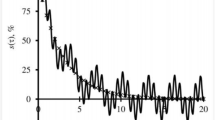Conclusions
In order to obtain more trustworthy results in analyzing dynamic processes recorded on oscillograms by means of high-frequency galvanometers, it is suggested to change the technique of calculating the integral distortion factor of amplitude-frequency characteristics and the maximum deviation of the amplitude from its theoretical value by using for comparison with the actual characteristics expression (4) instead of (2).
Similar content being viewed by others
Literature cited
É. Meier and K. Merder, Mirror Galvanometers and Instruments with Luminous Indicators [Russian translation], GÉI, Moscow (1959).
W. Härtel, Frequenz, Rb5, No. 9 (1951).
Additional information
Translated from Izmeritel'naya Tekhnika, No. 5, pp. 65–67, May, 1969.
Rights and permissions
About this article
Cite this article
Reznik, M.B. Evaluation of dynamic factors of high-frequency galvanometers. Meas Tech 12, 688–690 (1969). https://doi.org/10.1007/BF00994505
Received:
Issue Date:
DOI: https://doi.org/10.1007/BF00994505




